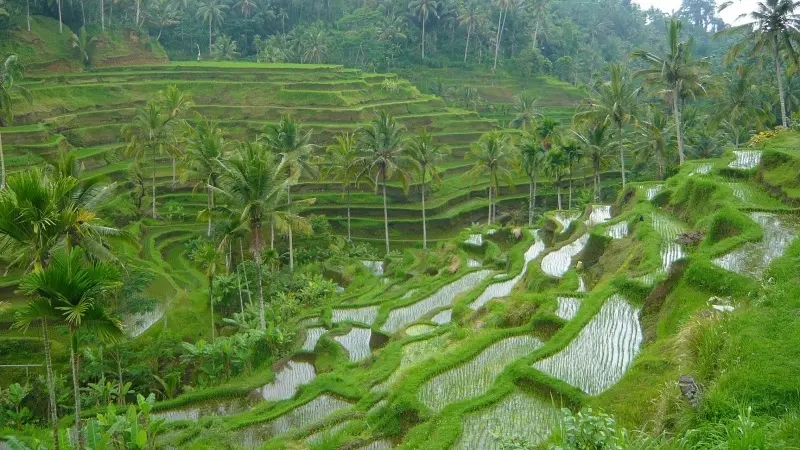Nestled in the heart of Bali’s lush countryside, the Ceking Rice Terrace offers a breathtaking panorama of meticulously arranged rice paddies cascading down steep hillsides.
Located near the village of Tegalalang, north of Ubud, Ceking is a showcase of traditional Balinese irrigation known as ‘subak,’ a cultural and agricultural marvel that reflects the island’s unique relationship with its natural landscape.
The Beauty of Ceking Rice Terrace
The rice terraces of Ceking are a mesmerizing sight, with vibrant green paddies that change hues with the seasons and the stages of rice cultivation.
The terraces are designed to follow the natural contours of the mountainside, creating a harmonious and sustainable agricultural system. The picturesque setting is a photographer’s and nature lover’s paradise, offering endless vistas of tranquil beauty.
The Subak System: A Cultural Heritage
The subak system, recognized by UNESCO as a World Cultural Heritage, is an age-old cooperative water management system that controls the water flowing from mountain tops to the rice fields.
It is not just about irrigation but also a philosophical concept that connects the Balinese Hindu culture with the natural world. The subak system is a reflection of the Tri Hita Karana philosophy, which focuses on the balance between humans, nature, and the divine.
The Best Time to Visit
The beauty of Ceking Rice Terrace changes throughout the year. The most picturesque times are during the planting season when the paddies are filled with water, creating reflective pools, and during the harvest season, when the rice plants are lush and green. Each season offers a unique perspective on the life cycle of rice cultivation.
Exploring Ceking Rice Terrace
Visitors to Ceking can walk along the narrow paths between the rice paddies to experience the terraces up close. There are also several vantage points and cafes perched high on the hillside, offering stunning views of the terraces while enjoying local Balinese coffee and cuisine.
The Surrounding Cultural Landscape
The area around Ceking Rice Terrace is dotted with temples, artisan villages, and local markets. A visit to the nearby village of Tegalalang offers a glimpse into the local craftsmanship, including wood carving and batik making. The region is a blend of natural beauty and cultural richness, making it a holistic Balinese experience.
Sustainable Tourism Efforts
The increasing popularity of Ceking Rice Terrace has led to efforts to promote sustainable tourism practices. Visitors are encouraged to respect the agricultural land, stick to designated paths, and support the local economy through responsible tourism practices.
Activities and Experiences
In addition to exploring the terraces, visitors can engage in various activities such as traditional farming tours, where they can learn about rice cultivation and even participate in planting or harvesting. The area also offers opportunities for cycling and trekking through the rural landscapes of Bali.
Getting There and Accessibility
Ceking Rice Terrace is easily accessible by road from Ubud, making it a convenient day trip for travelers staying in the town. The journey to the rice terraces is also an opportunity to admire the scenic beauty of Bali’s uplands.
Conclusion
Ceking Rice Terrace is more than just a scenic destination; it is a living representation of Bali’s cultural heritage and its symbiotic relationship with the environment.
The stunning landscape of terraced rice fields is a testament to the island’s traditional agricultural practices and a reminder of the beauty and sustainability that can be achieved when humans work in harmony with nature. A visit to Ceking offers a peaceful retreat into one of Bali’s most iconic and picturesque landscapes.
